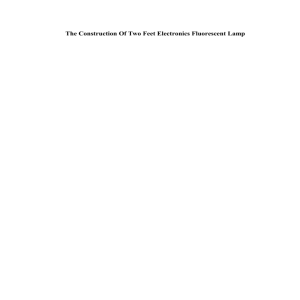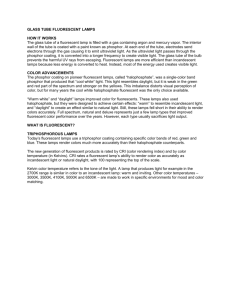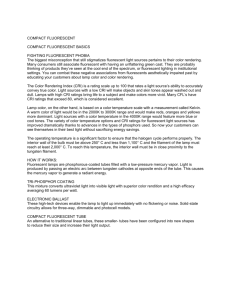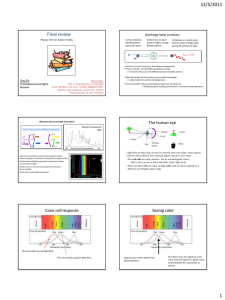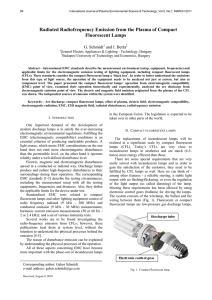Overview A fluorescent lamp is a long straight glass tube that glows
advertisement
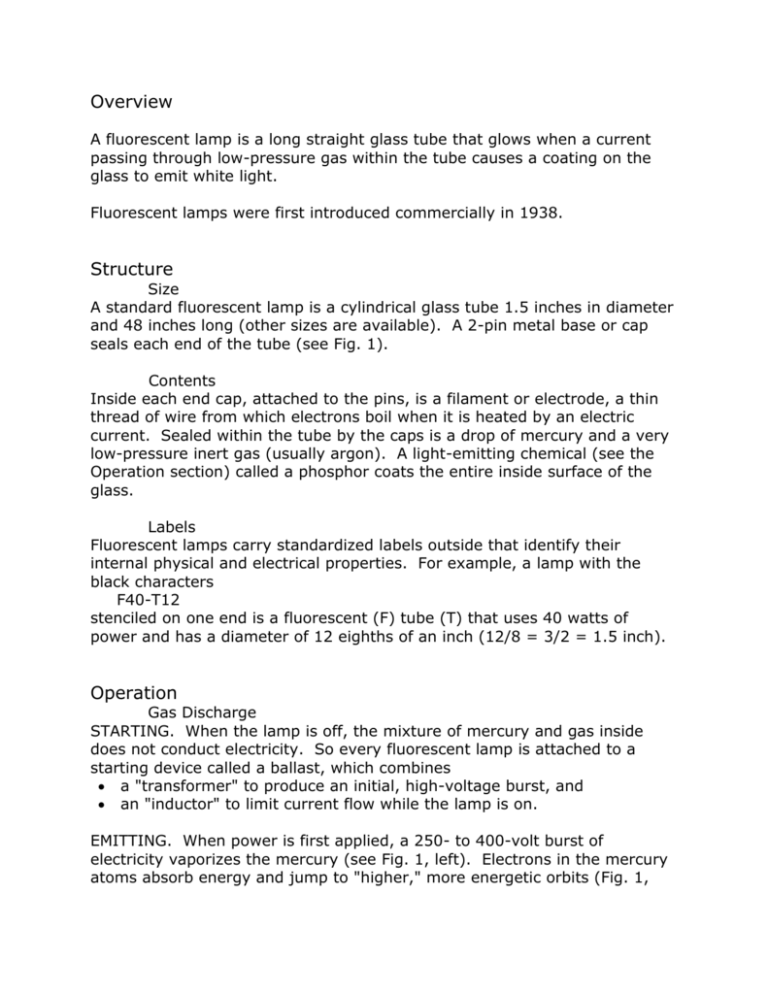
Overview A fluorescent lamp is a long straight glass tube that glows when a current passing through low-pressure gas within the tube causes a coating on the glass to emit white light. Fluorescent lamps were first introduced commercially in 1938. Structure Size A standard fluorescent lamp is a cylindrical glass tube 1.5 inches in diameter and 48 inches long (other sizes are available). A 2-pin metal base or cap seals each end of the tube (see Fig. 1). Contents Inside each end cap, attached to the pins, is a filament or electrode, a thin thread of wire from which electrons boil when it is heated by an electric current. Sealed within the tube by the caps is a drop of mercury and a very low-pressure inert gas (usually argon). A light-emitting chemical (see the Operation section) called a phosphor coats the entire inside surface of the glass. Labels Fluorescent lamps carry standardized labels outside that identify their internal physical and electrical properties. For example, a lamp with the black characters F40-T12 stenciled on one end is a fluorescent (F) tube (T) that uses 40 watts of power and has a diameter of 12 eighths of an inch (12/8 = 3/2 = 1.5 inch). Operation Gas Discharge STARTING. When the lamp is off, the mixture of mercury and gas inside does not conduct electricity. So every fluorescent lamp is attached to a starting device called a ballast, which combines a "transformer" to produce an initial, high-voltage burst, and an "inductor" to limit current flow while the lamp is on. EMITTING. When power is first applied, a 250- to 400-volt burst of electricity vaporizes the mercury (see Fig. 1, left). Electrons in the mercury atoms absorb energy and jump to "higher," more energetic orbits (Fig. 1, middle). They then fall back to less energetic orbits (Fig.1, right). This repeating process, called gas discharge, continuously emits the absorbed energy as light. Once started, only about 175 volts are needed to maintain this discharge in a 40-watt lamp. VISIBILITY. When an applied voltage causes discharge in some lowpressure, inert gases, they emit visible light. Ionized neon gas emits red light, for example, seen directly in a glowing neon bulb. But in a fluorescent lamp, the discharge comes almost entirely from the mercury vapor, even though it is only 1 percent of the enclosed gas. And almost all of the mercury discharge is ultraviolet (UV) light, whose wavelength is too short for human eyes to see. Wavelength Conversion The phosphor that coats the inside of the lamp tube converts the UV mercury discharge into useful light that people can see. The phosphor absorbs the invisible, short-wave UV emissions from the excited mercury atoms (Fig. 1, right). It then emits other light with a longer wavelength, almost all of which is visible. The chemical composition of the phosphor lining the tube controls the color of the visible light emitted, which may be "cool white" (partly blue), or "warm white" (partly pink), or other visible colors. Efficiency HEAT/LIGHT RATIO. All lamps convert current into visible light and heat. Fluorescent lamps are about 2 to 4 times more efficient than incandescent (glowing filament) lamps. For the same power, they produce 2 to 4 times more light and less heat. BULB LONGEVITY. Fluorescent lamps also have longer lifetimes. A typical incandescent bulb lasts 1000 hours before the filament fails. But a typical fluorescent lamp lasts 10,000 to 20,000 hours, depending on how often it is started.
